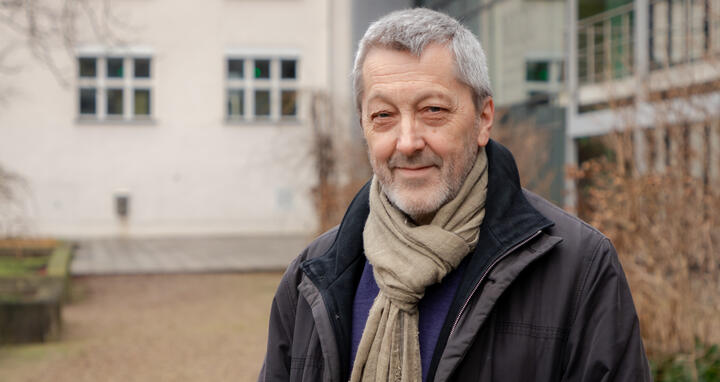Udo Heinemann: Structural biology helps us ask the right scientific questions
Chemists cook up substances; biologists count birds. The clichéd stereotypes of these disciplines suggest that their view of nature is separated by several magnitudes of scale, and in some way that's indeed the case. Structural biology is a discipline that operates at tiny scales of space and asks biological questions that touch upon chemistry and physics. What's the shape of a protein and how does this influence its function? How are the atoms of an enzyme arranged so that a certain biochemical reaction can take place? From an early stage in his career, Prof. Udo Heinemann was fascinated by the challenge of looking at biology through the eyes of a chemist. He studied in Göttingen, where there was no course in biochemistry as such. So he simply attended lectures on topics like microbiology and plant physiology.
Then his interests took him to the Max Planck Institute of Experimental Medicine in Göttingen, where he worked in a group led by renowned structural biologist Wolfram Saenger. He earned his doctorate there in 1982. After completing a postdoc at UCLA, Heinemann moved to the Freie Universität Berlin, where he worked as an assistant professor, obtained his qualifications as a professor, and gained a Heisenberg grant. He joined the MDC in 1993. Together with other group leaders, he was instrumental in setting up and shaping the research institute from those decisive early years. He is now firmly established here as a biochemist and structural biologist.
One of Heinemann’s primary interests is the three-dimensional shape of molecules and how that defines their function. Biological molecules are like machines whose workings can be deciphered using the methods of structural biology. Heinemann is particularly interested in nucleic acids and the proteins that interact with them; he says he has been enthralled by those topics since his doctorate. These interactions guide cellular processes that influence, for example, the activation of genes. Another of his interests is processes in cellular transport that are involved, for instance, in quality control during the production of proteins.
X-ray crystallography is a tool and a form of art
The core competence of Udo Heinemann’s research group is a procedure for clarifying the spatial arrangement of all the atoms in a molecule: X-ray crystallography. To use this methodology, a molecule must be crystallized – it has to form large, extremely regular aggregates – and the crystal is then irradiated with short-wave X-rays. The electron shells of the crystal's atoms diffract light and, through the regular arrangement of the crystal lattice, the diffracted light beams form a characteristic pattern of dots that can be detected behind the crystal (see image). Then, based on the dots on the diffraction image, computers calculate the 3D structure of the whole molecule. This process fascinated Udo Heinemann: “X-ray crystallography used to be considered extremely exotic, complicated and demanding. That is why I’ve found it so very interesting.”
Expertise in great demand
Even today, crystallizing proteins is still a challenge. To produce crystals of high quality, the molecules must be extremely pure and available in large quantities; certain salts and additives must be mixed in during crystallization, and scientists must vary the pH, temperature and protein concentration. Sometimes the protein itself must also be modified. For success, experience and intuition are invaluable.
So not just anyone can “do” crystallography, which is why the expertise of Heinemann’s laboratory is in such demand. The structures they obtain are ideal for combinations with other methods, such as computer models and magnetic resonance imaging, but also biochemical and functional tests. “Structural biology is very useful for generating hypotheses,” says Heinemann. That is why so many researchers at the MDC, on the Buch campus, and throughout the world collaborate closely with Udo Heinemann and his team. The Helmholtz Protein Sample Production Facility makes the laboratory’s resources and experience in protein purification and sample production available to other scientists. Udo Heinemann has an outstanding reputation in the field. For three years from 2009, he was President of the German Association of Crystallography (DGK) and right now, is Vice President of the European Crystallographic Association (ECA).
On the DFG Review Board Heinemann will make decisions on research proposals
Recently Heinemann's peers from across Germany also elected him onto the DFG’s Review Board for Structural Biology. Such Review Boards primarily make decisions on the allocation of research funding, but also on research grants and on applications to the Emmy Noether Programme. Members of the boards are elected by direct democratic vote. Anyone who works in research and holds a doctorate may participate in the election. “That’s the great thing about the Review Boards,” says Heinemann. “It’s quite an exceptional mechanism.”
The four researchers who sit on each Review Board ultimately decide whether a project will receive DFG funding or not. At their quarterly meetings, Review Board members discuss the potential of each project in question: “We take a close look at whether it asks the right questions, and whether a problem will be addressed with the right methods,” Heinemann explains.
It isn’t easy to ask good questions about a scientific problem, yet throughout his career Udo Heinemann has done so. He has followed his interests, solved complex problems, and established a position as an outstanding researcher whose expertise is much sought-after around the world. But yet he admits that he had a lot of luck in the critical period between starting his doctorate and getting his appointment as a professor: “For some reason I was spared those extremely difficult moments.”









